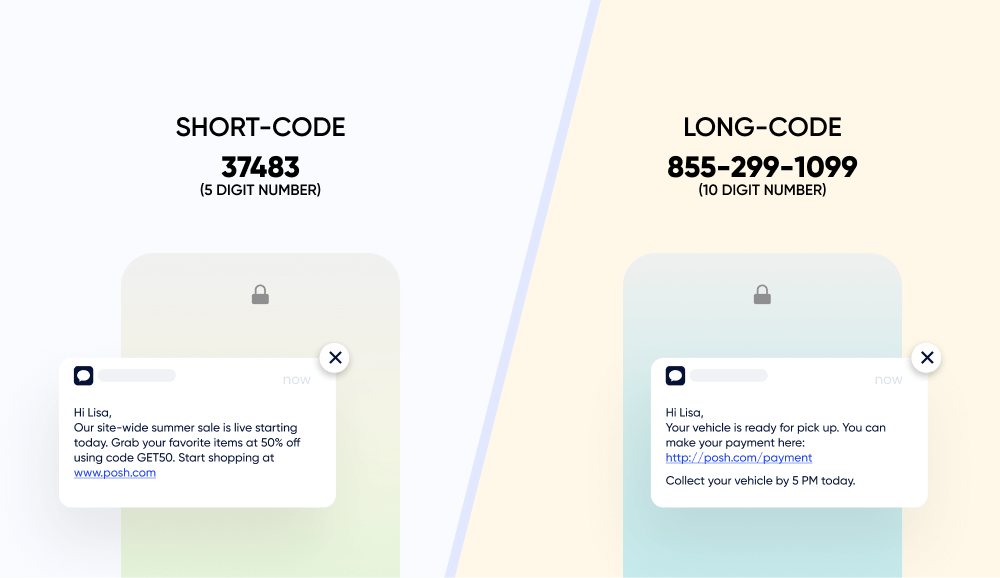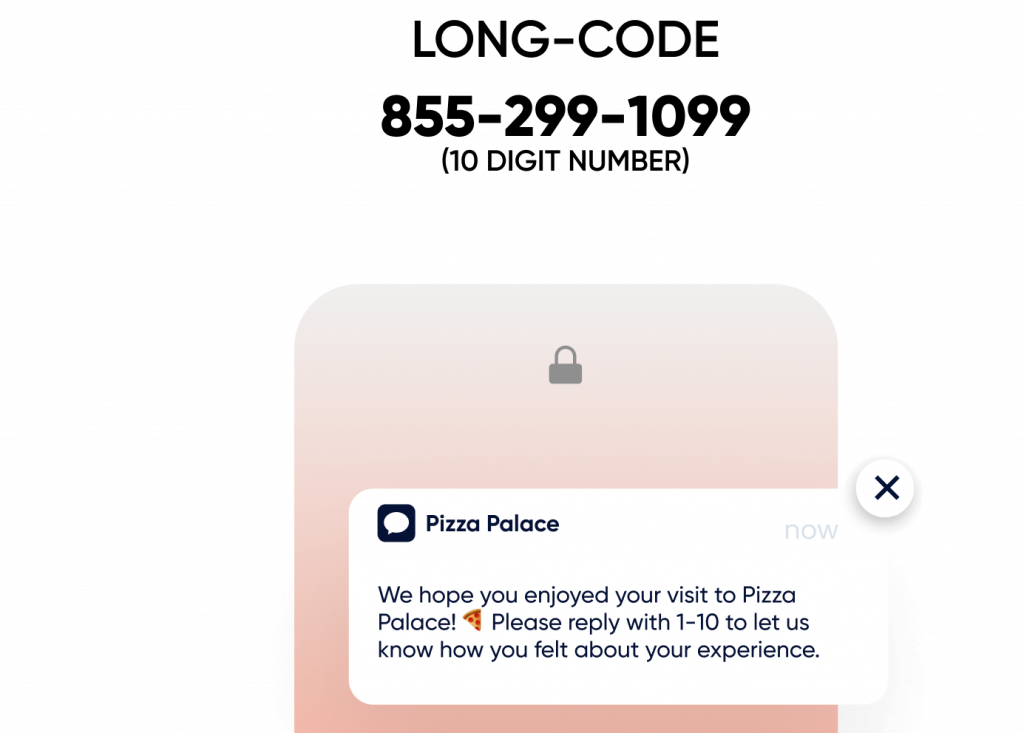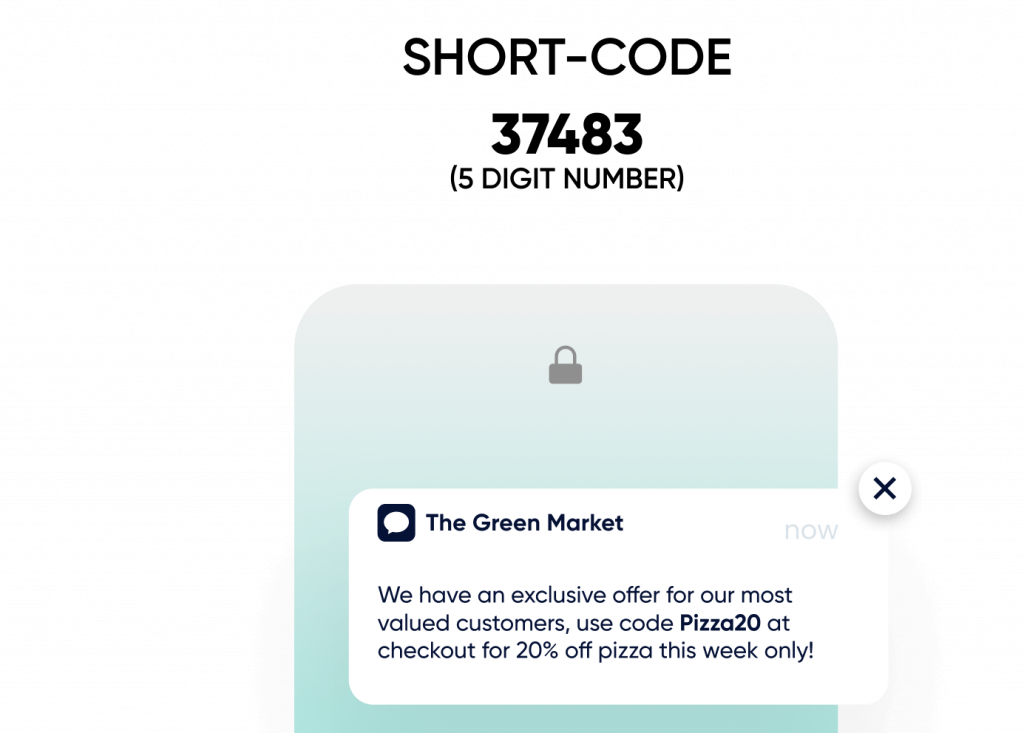 Katie Morley
Katie Morley
Jul 1, 2023
 Katie Morley
Katie Morley
Jul 1, 2023
SMS marketing has emerged as a powerful customer engagement tool for businesses—it’s no surprise that marketing teams are tapping into the 98% open rates.
Getting started with SMS marketing can be confusing. For instance, where do you start when choosing between short and long codes? Especially when the number you pick could be the difference between success and failure with your SMS campaigns.
This blog explores the differences between long codes and short codes. It delves into the advantages and disadvantages of each type of SMS marketing number, before discussing which option could be best for your business needs, and the best way to start SMS marketing.
SMS long codes explained
How to get started with long codes
Short codes
Advantages of short codes
Long code or short code: which is best for you
Getting started with short codes
The right choice depends on your needs

An SMS long code (toll-free or 10DLC) is a long phone number with either a country or local code, and can be used for SMS marketing.
Depending on your location, SMS long codes can take two forms:
You can text-enable your existing local number, with calls functioning as usual while texts are routed to your chosen SMS marketing platform. Businesses often prefer local numbers because they have recognizable area codes that instill trust, they are approved for high-volume bulk SMS, and setting up a local number is typically quick and cost-effective.

Due to familiarity with the number, long codes can be better for creating a personalized and human approach. This makes them ideal for customer support, appointment reminders, or survey requests. A business choosing a long-code phone number should also know that long code can both send and receive phone calls, while short code is exclusively for SMS.
Another major advantage of long codes is how easy they are to set up. Long codes are easier and quicker to obtain than short codes. This accessibility makes them a great cost-effective solution for small businesses or those with limited budgets.
Toll-free numbers do allow for bulk messaging, making them suitable for businesses that need to communicate with customers more frequently. However, they’re subject to throughput limits, meaning you can only send a limited number of messages per minute per code. Because of this, they may not work for large-scale campaigns involving high message volumes.
To get started with long code, you’ll need to choose one of the following methods:
For most businesses, it’s a priority to find an SMS platform that can automate the process and include SMS into a wider journey orchestration to help nurture new and returning customers.
⭐⭐⭐⭐⭐
“SMS marketing with Insider has exceeded all of our expectations. Our only regret is not using it sooner. Our conversion rates have skyrocketed, and the combination of SMS with other channels has made customers more responsive than ever.”
- VP of Marketing | Global pizza delivery brand
As the name suggests, short codes are shorter than long codes. They’re usually five to six digits in length, and are specifically designed for high-volume, mass messaging. This makes them ideal for many marketing campaigns and promotions.
There are two main types of short codes: shared and dedicated. Shared short codes are literally that: codes that multiple businesses use at the same time. Each business receives a unique keyword they use to identify their campaign.
Why would any business want to share a short code? Because they’re more cost-effective. The businesses sharing the code also share the cost. As you might expect, however, this comes with limitations in terms of availability. There’s also a risk of keyword conflicts if multiple businesses in the same industry use the same code.
Dedicated short codes offer a higher level of control and customization. A business has complete ownership over these codes, helping to ensure brand consistency. While dedicated short codes are more expensive, they’re more reliable and eliminate the risk of keyword conflicts.
Short codes offer several advantages over long codes that make them an attractive option for many organizations:

There’s a lot of info out there on the different types of SMS code. To make things easier, here are four key factors to consider when deciding between long codes and short codes:
⭐⭐⭐⭐⭐
“For such an extensive platform, Insider has made learning the tool incredibly easy. After joining for Architect, its cross-channel journey builder, we decided to add SMS to our marketing channels and have been wowed by the results. We have consistent open rates of 96%, and SMS has increased our CVR by 8%.
- Marketing Director | Fashion retailer
To get started with short code SMS, you’ll first need to apply for an SMS short code and register with an SMS marketing platform.
While short code SMS is the most expensive option, for large businesses the investment will be worth it. The easy-to-remember nature of short codes makes them ideal for additional marketing campaigns, and if you’re using SMS as part of a wider cross-channel strategy, the unlimited sending capability means your customers will never miss out.
By now you should have a clearer understanding of the difference between SMS long and short codes, and why you would choose one over the other. By considering your budget, campaign objectives, and target audience, you can make an informed decision that will increase your chances of success.
Design personalized, contextual, and timely SMS messages using A2P in the Insider platform. Keep your customers engaged and show users the value your brand brings to their lives every day on their favorite device.
Book a demo with one of our experts to learn more about how Insider can transform your marketing campaigns with SMS.

Written by
Katie Morley
Katie is an award-winning content marketer with over eight years of experience in content strategy, development, and copywriting. As Global Content Director at Insider, she currently oversees content strategy across 26 regions. Fun fact: Katie read 64 books last year (for which she owes a long commute and two week-long holidays where she spent approximately six hours a day with her nose in a book).